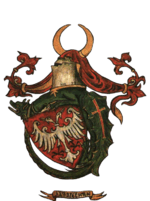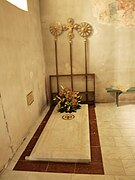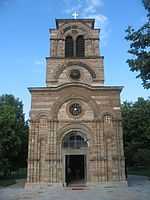Stefan Lazarević
| Stefan Lazarević | |
|---|---|
| Despot of Serbia | |
|
| |
| Reign |
Knez (1389–1402) Despot (1402–1427) |
| Predecessor | Lazar of Serbia |
| Successor | Đurađ Branković |
| House | House of Lazarević |
| Father | Lazar of Serbia |
| Mother | Princess Milica of Serbia |
| Born |
1377 Kruševac, Moravian Serbia |
| Died |
1427 Glava, Serbian Despotate |
| Burial | Manasija Monastery |
Stefan Lazarevic (Serbian: Стефан Лазаревић, c. 1377–19 July 1427) known also as Stefan the Tall (Стеван Високи), was the son of Prince Lazar Hrebeljanović and a ruler of Serbia. He held a title of prince (1389-1402) and despot (1402-1427). In his time he was regarded as one of the finest knights and military leaders, and because of his literature works he is regarded as one of the best Serbian writers in the Middle ages. After the death of his father on the Kosovo Field in 1389, he became ruler of Moravian Serbia and ruled with his mother Milica Hrebeljanović, until he reached adulthood in 1393. His reign and his personal literary works are sometimes associated with early signs of the Renaissance in Serbian lands. He introduced knightly tournaments, modern battle tactics, and firearms to Serbia.
As an Ottoman vassal, Lazarević was leader of Serbian auxiliary squads in the battle of Rovine, Nicopolis and Angora. After the battle of Angora, Lazarević received the title of despot from the Byzantines in Constantinople, in 1402.
In 1403–04 he became an ally of Hungarian king Sigismund, and received Mačva, Belgrade (which became Lazarević's capital in 1405), Golubac and other domains, such as Srebrenica in 1411. In 1408 Sigismund founded the Order of the Dragon, a chivalric order for selected nobility, in which Stefan had the superior rank.
After the Ottoman defeat on Angora, civil war erupted in the Ottoman Empire, while clashes among Serbian nobility ensued. First, between Lazarević and Branković, secondly between Stefan and his younger brother Vuk. The clashes among the nobility ended in 1412, with the conciliation of Stefan and his nephew Đurađ Branković. After the death of Balša III Balšić, he inherited Zeta and waged the war against Venice. Since he didn't have any children, on the assembly in Srebrenica (1426), Stefan proclaimed his nephew Đurađ as heir.
On the domestic front, he broke the resistance of the Serbian nobles, and used the periods of peace to strengthen Serbia politically, economically, culturally and militarily. On 29 January 1412 he issued the "Code of mines" (Законик о рудницима), with a separate section on governing of Novo Brdo – the largest mine in the Balkans at that time. This code increased the development of mining in Serbia, which has been the main economic backbone of Serbian Despotate. At the time of his death, Serbia was one of the largest silver producers in Europe. In the field of architecture, he continued development of Morava school.
He was a great patron of the arts and culture by providing shelter and support to scholars from Serbia, and refugees from neighboring countries that have been taken by the Ottomans. In addition, he was himself a writer, and his most important work is "A Homage to Love," which is characterized by the Renaissance lines. Beside despot’s literature work, in this period there were other authors such as Constantine the Philosopher and Gregory Tsamblak. During his reign the Resava school was formed.
Background and family
Stefan was the son of Lazar and his wife Milica, a lateral line of Nemanjić. Hrebeljanović's father Prince Vratko was a direct descendant of Vukan, eldest son of Stefan Nemanja. In addition to Stefan, they had seven other children.[1][2][3]
| Stefan's brothers and sisters | |||
|---|---|---|---|
| Stefan's brothers | |||
| Name | Lifespan | Title | |
| Dobrovoj | (Died as a child) | ||
| Vuk | (?—1410) | prince | |
| Stefan's sisters | |||
| Name | Lifespan | Marriages | |
| Мara | (?—1426) | Vuk Branković, c. 1371[1][2][4] | |
| Jelena | (?—1443) | 1.Đurađ II Stracimirović Balšić (1385 — 1403), c. 1386[1][2] 2.Sandalj Hranić (1392 — 1435), 1411 | |
| Dragana[3][4] | (?—?) | Ivan (1371 — 1395) or his son Alexander, c. 1386[4] | |
| Teodora (Jelena) | (?—before 1405)[3] | Nikola II Gorjanski, c. 1387[1][2] | |
| Olivera | (c. 1378[1] — after 1443[2][3]/1444[1]) | Bayezid I (1389—1403), 1390 | |
Stefan Lazarević married Jelena in September 1405. Jelena was daughter of Francesco II Gattilusio, a Genovese lord of Lesbos and a sister of Irene Gattilusio, empress of Byzantium empire and a wife of John VII Palaiologos. This marriage was arranged during his stay in Constantinople in 1402, at a time when the city and the Byzantine Empire ruled John VII in the name of his uncle, Manuel II (1373-1391 ruler, Emperor 1391-1425). Jelena and Stefan had no children and Jelena is not shown on any frescoes in monasteries built by Stefan.[4]
Life
Stefan was the son of Prince Lazar, whom he succeeded in 1389. Nikola Zojić attempted to overthrow Stefan Lazarević at the end of 14th century and used Ostrvica as haven after his attempt failed.[5] Lazarević participated as an Ottoman vassal in the Battle of Rovine in 1395, the Battle of Nicopolis in 1396, and in the Battle of Ankara in 1402.[6] He became the Despot of Serbia in 1402 after the Ottoman state temporarily collapsed following Timur's invasion of Anatolia with the Battle of Ankara, where he and his Serbian Knights fought well and a good portion of his forces survived. While stopping at Constantinople on his way home, he was well received by the Emperor who granted him the title of Despot by which he was to be known from then on and by which his successors were also to be known. At first Stefan's policy seems to have been to take advantage of Ankara to shed Ottoman vassalage and to assert Serbia's independence. Stefan's nephew George Brankovic who had no love for Stefan soon lined up with Suleyman a son of Bayezid (Ottoman Sultan 1389-1402) against Stefan. Not surprisingly Stefan was receptive when Sigismund of Hungary approached him for an alliance. Sigismund was very generous in his terms. He offered Stefan Lazarevic Macva including Beograde for Stefan's lifetime if he would accept Hungarian suzerainty for it. In the interim, In November 1402 Stefan defeated Brankovics's forces (which included troops from Suleyman) at Tripolje. At this time Stefan also acquired from Sigismund the important fortress of Golubac on the Danube. In 1403 he proclaimed Belgrade his capital. He built a fortress with a citadel which was destroyed during the Great Turkish War in 1690; only the Despot Stefan Tower remains today.[7] In 1404, Sigismund gave Lazarević land in the present-day Vojvodina (and Pannonian part of present-day Belgrade), including Zemun (today part of Belgrade), Slankamen, Kupinik, Mitrovica, Bečej, and Veliki Bečkerek. In 1417, Apatin is also mentioned among his possessions.
Under his rule, he issued a Code of Mines in 1412 in Novo Brdo, the economic center of Serbia. In his legacy, Resava-Manasija monastery (Pomoravlje District), he organized the Resava School, a center for correcting, translating, and transcribing books.[7]
Stefan Lazarević died suddenly in 1427, leaving the throne to his nephew Đurađ Branković. His deeds eventually elevated him into sainthood, and the Serbian Orthodox Church honors him on 1 August. Despot Stefan is buried in the monastery Koporin which he had built in 1402, as he did the bigger and more famous Manasija monastery in 1407. In fact, Manasija was intended as his own burial place, but due to a sudden nature of his death in perilous times it was his brother Vuk that is buried there.[7]
Apart from the biographical notes in charters and especially in the Code on The Mine Novo Brdo (1412)
| Wikisource has original text related to this article: |
Stefan Lazarević wrote three original literary works:
- The Grave Sobbing for prince Lazar (1389)
- The Inscription on the Kosovo Marble Column (1404)
- A Homage to Love (1409), a poetic epistle to his brother Vuk.[7]
He was probably the patron of the most extensively illuminated Serbian manuscript, the Serbian Psalter which is now kept in the Bavarian State Library in Munich.[8]
Military campaigns
| ||||||
Titles
- "Lord of all the Serbs and Podunavlje" (господар свих Срба и Подунавља[9]), inherited through his father.[10]
- "Despot of the Kingdom of Rascia and Lord of Serbia" (Stephanus dei gratia regni Rassia despotus et dominus Servie[11]). After 1402.
- mentioned as "Stephanus Despoth, Dominus Rasciae" in the founding charter of the Order of the Dragon (1408). He was the first on the list.[12]
Marriage
On 12 September 1405, Stefan married Helena Gattilusio, the daughter of Francesco II of Lesbos. According to Konstantin the Philosopher, Stefan first saw his wife on Lesbos, where Francesco II offered him a choice among his daughters; the marriage was arranged "with the advice and participation" of Helena's sister, Empress Eirene. Surprisingly, there is no mention of Helena after her marriage to Stefan; this led Anthony Luttrell to remark that "apparently there were never any children; nothing is known of her death or burial; and, most unusual, she did not appear in any of the post-1402 fresco portraits of Stefan".[13] Luttrell concludes "Maybe she was too young for the marriage to be consummated, and perhaps she stayed on Lesbos and never traveled to Serbia; possibly she died soon after her marriage."[14]
Gallery
-

Despot Stefan Lazarević's Seal, 1415 AD
-

Lazarević dynasty coat of arms
-

Monument.
-
Despot Stefan Lazarević Memorial in the courtyard of a church in Crkvine, Mladenovac
-
Tomb.
See also
- Serbian Despotate
- House of Lazarević
- Order of the Dragon
- List of Serbian monarchs
- History of Serbia
References
- ↑ 1.0 1.1 1.2 1.3 1.4 1.5 Ivić, Aleksa (1928). Родословне таблице српских династија и властеле. Novi sad: Matica Srpska. p. 5.
- ↑ 2.0 2.1 2.2 2.3 2.4 "Genealogy - Balkan states: The Lazarevici". Retrieved 25 February 2010.
- ↑ 3.0 3.1 3.2 3.3 "Medieval Lands project - Serbia: ''Lazar I [1385]-1389, Stefan 1389-1427''". Retrieved 25 February 2010.
- ↑ 4.0 4.1 4.2 4.3 Андрија Веселиновић Радош Љушић, „Српске династије" , Нови Сад, 2001. ISBN 86-83639-01-0
- ↑ Đurđe Bošković (1956). Arheološki spomenici i nalazišta u Srbiji: Centralna Srbija. Naučna knjiga. p. 54. Retrieved 5 July 2013.
- ↑ The Balkans, 1018-1499, M. Dinic, The Cambridge Medieval History, Vol. 4, Ed. J.M.Hussey, (Cambridge University Press, 1966), 551.
- ↑ 7.0 7.1 7.2 7.3 Fine, The Late Medieval Balkans (1987)
- ↑ "Serbian Psalter, Cod. slav. 4". Bavarian State Library.
- ↑ Miloš Blagojević (2004). Nemanjići i Lazarevići i srpska srednjovekovna državnost. Zavod za udžbenike i nastavna sredstva.
У jедноj хиландарс^' пове- л>и деспот Стефан истиче да jе постао господар свих Срба и Подунавља
- ↑ Istorijski glasnik: organ Društva istoričara SR Srbije. Društvo. 1982.
На основу досадашњег излагања са сигурношћу можемо рећи да деспот Угљеша , господин Константин , Вук Бранковић , Вукови синови и кесар Угљеша никада нису носили титулу „ господар Срба и Подунавља ” , јер је ова ...
- ↑ Radovi 19. 1972. p. 30.
Stephanus dei gra- tia regni Rassia despotus et dominus Servie
- ↑ Ekaterini Mitsiou (2010). Emperor Sigismund and the orthodox world. Austrian Academy of Sciences Press. p. 103. ISBN 978-3-7001-6685-6.
The first name to appear is Stephanus Despoth, Dominus Rasciae
- ↑ Anthony Luttrell, "John V's Daughters: A Palaiologan Puzzle", Dumbarton Oaks Papers, 40 (1986), p. 105
- ↑ Luttrell, "John V Daughters", p. 106
Further Readings
- Constantine the Philosopher wrote a biography to Stefan in ~1431. Constantine was a Bulgarian scholar who following his arrival in Serbia in 1411, made a career for himself at Stefan's court.
- Fine, John V.A. The Late Medieval Balkans: A Critical Survey from the Twelfth Century to the Ottoman Conquest. University of Michigan Press, Ann Arbor, 1987.
External links
| Wikimedia Commons has media related to Stefan Lazarević. |
- Despot Stefan Lazarević, a fresco from the monastery of Manasija from the year 1418
- His listing in "Medieval lands" by Charles Cawley. The project "involves extracting and analysing detailed information from primary sources, including contemporary chronicles, cartularies, necrologies and testaments."
| Stefan Lazarević House of Lazarević Born: circa 1372/77 Died: 19 July 1427 | ||
| Regnal titles | ||
|---|---|---|
| Preceded by Lazar of Serbia |
Serbian Knez 1389–1402 |
Vacant Title next held by Đurađ Branković |
| New creation | Serbian Despot 1402–1427 | |
| ||||||||||||||||||||||||||||||||||||||
| ||||||||||||||||||||||||||||||||||||||||||||||||||||||||||||||||||||||||||||||||||||||||||||||||||||||||||||||||||||||||||||||||||||||||||||||||||||||||||||||||||||||
|


